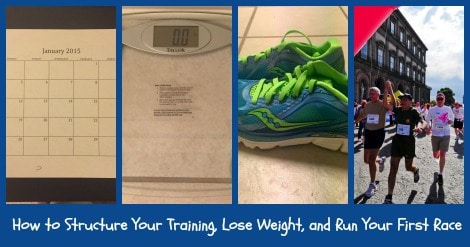Most articles about training center on how to run your fastest race possible. This is logical given the somewhat universal physiological realities of trying for a new personal best – the lessons can apply to everyone.
However, simply running faster is not always the only goal runners have, especially for beginner runners.
Many new runners, in addition to wanting to challenge their physical limits, want to improve their lifestyle, lose weight, and generally live healthier lives.
Those are some pretty smart goals if you ask me.
Unfortunately, most beginners don’t feel like “real runners” if they are primarily motivated by getting healthier, losing weight, or challenging themselves by simply running a race distance they never thought possible.
Worse yet, there isn’t a lot of information or examples of how this can be done, what challenges you’ll face, and strategies for achieving your goals.
Luckily, this article is going to show you – using behind-the-scenes insights from a successful case study – exactly how you can develop your own strategy for success.

Setting the stage
 I think the best way to show you exactly how the strategy I am about to outline can work for you is to highlight exactly how this worked for one of the athletes on the RunnersConnect team – Joy Duling.
I think the best way to show you exactly how the strategy I am about to outline can work for you is to highlight exactly how this worked for one of the athletes on the RunnersConnect team – Joy Duling.
By sharing Joy’s story, you can see the exact struggles she faced and relate them to what you might be struggling with; witness how she overcame these adversities and what you can apply to your current training, and get motivated from her results.
So, who is Joy Duling and what can you learn from her?
Joy started working with the RunnersConnect team a little over a year ago. When she joined the team she was struggling with a variety of health issues, including:
- Being 55 pounds overweight
- 3 different medications for her health
- Had blood pressure and cholesterol numbers through the roof
- Had never finished a race – and really wasn’t even running at this point
Joy knew she needed to make a change in her health, so she signed up for a local half marathon just hoping to walk it.
But, as the race date kept getting closer, she was increasingly nervous about her ability to finish and was becoming frustrated with a lack of results.
What challenges did she face getting started with running?
- Joy started by simply walking (and covering a good amount of distance per day – 60 minutes or more) but was losing motivation quickly due to lack of progress. The problem was that while walking started out feeling like a good achievement, it quickly wasn’t giving her the physical rush that she wanted to see after investing so much time. She wanted to push herself more to get back that sense of accomplishment.
- Likewise, Joy wasn’t seeing the improvements in her overall health that would keep her motivated. She was losing some weight, but not as much as she liked, and she still felt like she relied too heavily on medications to keep her healthy.
- Joy was also starting to get cold feet about being able to actually walk the half marathon I signed up for, which was causing a lot of anxiety and trying to find ways not to do the race or get in her daily training
How Joy succeeded (and what you can learn and implement from her story)
Now that I’ve shared Joy’s story, I want to share the specific step-by-step process we took in hopes that you can learn valuable lessons you can apply to your own training.
Here are the three keys to Joy’s success:
Developing a gradual plan that works for you
The first step we took with Joy was building her a very gradual run-walk plan that slowly transitioned her into running full-time.
Joy started with 9 minutes walking and 1 minute running. Each week we worked to increase the ratio of running to walking.
The progression was slow enough that Joy never felt like she was taking too big of a jump. More importantly, because the plan was structured to her current fitness level each week was a challenging, yet comfortable step forward.
“By having a structured plan in place, it helped me avoid the temptation to do too much, too soon. I also felt a lot more confident. Previously, I would visit running message boards and solicit advice from other runners, but everyone had a different take on what I should be doing and I lost motivation seeing the rapid progress some runners seemed to be making. But, with a plan in place, it was a huge weight off my shoulders.”
Your takeaway: If you’re new to running, don’t be afraid to utilize the run/walk method
For beginner runners, the run-walk method allows you to exercise for a longer period of time each session. This increases your aerobic capabilities more rapidly, burns more calories, and reduces your risk of injury.
Most beginner runner struggle to run more than 1 to 3 miles at a time. As such, their time spent running is typically only 15-30 minutes per session. However, from research, we know that aerobic development peaks between 30-90 minutes of exercise. Therefore, any training method beginners can implement to increase their exercise time in the early stages of their training will help them develop more rapidly.
By breaking down a training run into a run/walk session, it provides new runners the ability to recover their breathing and gives their muscles a rest. This can help them extend their training sessions beyond 30 minutes while also making it less difficult on the body. Not only does this help increase fitness, but it reduces the likelihood of injury since they are not stressing the structural system beyond its capabilities.
Furthermore, studies have shown that there is only a small difference between the number of calories burned while running easy and the number of calories burned at a brisk walk. When you factor in the fact that the run/walk method allows a runner to almost double or triple their time spent exercising, new runners are able to burn more calories than they would simply by running alone.
Nab Our FREE 4-part Weight Loss Email Course
You’ll learn the science behind losing weight and still running well so you can understand the “why” of weight loss for long-term success.
Lessons include why simply running more and eating less won’t help you lose weight, why your weight fluctuates each day, and the best way to distribute calories throughout your day. Plus more…
Taking things one step at a time
We kept the focus of the training on a 3-4 week blocks and periodically reviewed her progress for motivation.
New runners are often intimidated by what their training plan calls for months down the road because they can only relate to what their fitness level is at the moment.
By keeping the focus on the training for that week, it prevented Joy from getting overwhelmed and believing the training plan was too daunting.
Also, each month we conducted a review by looking at her logs on our training platform. This helped her see how far she had come during that time. It can be easy to lose sight of how much progress you’ve made.
As an example, after a few months Joy had progressed to the point where she was running 4-5 mile long runs without stopping. However, after struggling to finish 6 miles one day, she began to question whether she could run a full half marathon. Our coaching staff asked her to look back two months in her logs and remember how daunting running just 2 miles seemed. After reflecting and seeing the data, it helped her appreciate how far she had already come and renewed her motivation.
Your takeaway: Focus on the training for this week. Don’t look too far ahead on the schedule and don’t forget to celebrate the small wins.
One of the primary reasons new runners quit their sport is that their ultimate goal seems too daunting. When they compare the training they will need to do months down the road to where they are at now, it seems impossible for them to get there…so they give up.
To combat this, focus only on your training and progress for two to three weeks at a time. This provides enough challenge to keep you motivated, but won’t intimidate you.
Also, take the time to reflect on how far you’ve come. You can do this by logging your runs and workouts and periodically looking back to measure progress. Or, you can set some type of intermediary goals – like finishing a 5k and then finishing a 10k.
It’s ok to have bad weeks of training
We helped Joy battle through these rough patches by teaching her the secret of the “reset button”
You’re going to have bad days, and even weeks, of training. It could be from getting sick, being busy at work, travel or a myriad of other reasons. Regardless, it happens to everyone (even those speedy elites who win races).
Joy had countless days and weeks like this. I tried to go back and count exactly how many and when they occurred, but over the past year there have been too many examples.
The secret is not letting these bad days and weeks throw you off your long-terms goals.
With Joy, we implemented a trick called “hitting the reset button”.
Mentally, the goal with this trick was to clear the mind of everything bad that happened that day or week and start the next day fresh and ready to take the next logical step forward.
Your Takeaway: Rather then let those setbacks throw you completely off course, learn to hit the reset button.
Whether you need to reset that day or the entire week, it’s ok. Hit the mental reset button when you go to sleep and clear out all the mistakes and bad things that happened. When you wake-up, it’s a fresh start. What happened yesterday or the week before doesn’t matter.
Today is a new day and within your control to make it a positive step forward.
The results
The best part about being a coach is seeing the progress your athletes make and how it changes their life and perspective of what they can and can’t do.
For a quick recap, here are the results Joy achieved:
Lost 55 pounds
Through our time working with her, Joy lost 55 pounds and is getting fitter every week. I will be the first to admit that Joy’s weight loss isn’t all directly related to running. Weight loss also requires hard work and dedication nutritionally.
However, I think the consistency running added to Joy’s daily routine helped her stay more disciplined when it came to nutrition and prevented the peaks and valleys that often accompany weight loss.
More importantly, I think having a goal outside weight loss – like finishing a half marathon – helped take the pressure off the numbers on the scale and provided a tangible goal to work towards. This helped keep Joy motivated and focused on the process of getting healthier – not the numbers on the scale.
Blood pressure and cholesterol numbers back under control – without medication
As I mentioned at the start of this article, not all running goals are directly related to performance. Joy was able to wean herself, under a doctor’s orders, off all her medications. Her blood pressure and cholesterol numbers were now in check naturally.
Not only does this improve Joy’s quality of life and overall health, but I noticed it also had a dramatic impact on what she believed possible. Rather than accepting the status quo, Joy’s outlook and self-belief is overwhelmingly positive.
Finished her first HM – running
Finally, Joy was able to finish her first HM – running almost the entire way. Even better, she’s excited about tackling the next one, improving her time, and even training for a marathon next!
You can hear what Joy was able to accomplish, in her own words, in this great video she sent us.
Are you ready to get healthier and more consistent with your training?
I sincerely hope detailing Joy’s struggles, her journey, and her success is the motivation and advice you need to make the next steps in your quest to become a healthier, life-long runner.
If you’d like to work with us to develop your own custom training plan and receive the coaching support you need to achieve your goals, check out our affordable coaching and training plans: Click here to learn how we can help





3 Responses
We’re proud of you Joy! What a great story to encourage others to get out there and try talking the journey to the real corner of healthy and happy, and I’m not talking about the corner drug store. I can’t wait to see what’s ahead for you!
i am inspired and happy to read Joys story and well i also inculcate some of the advises given to her
Very good to hear such a success story!